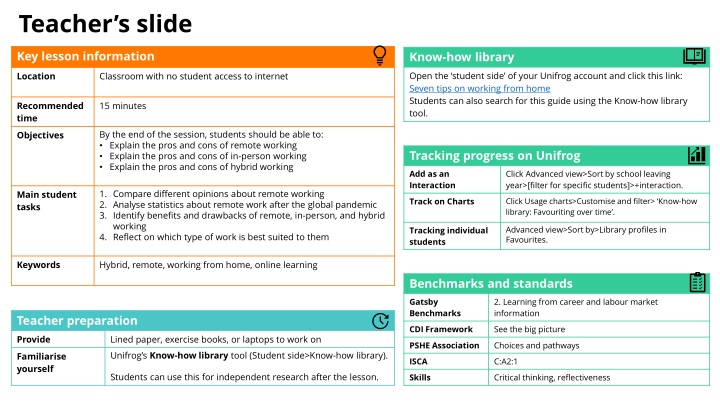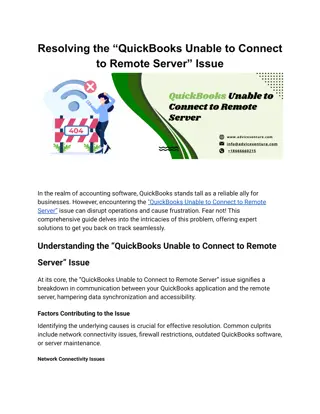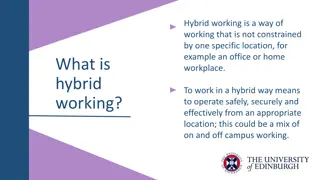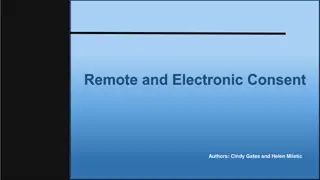Seven Tips on Remote, In-person and Hybrid Working
In this lesson, students will explore the pros and cons of remote, in-person, and hybrid working models. They will analyze different viewpoints, statistics post-pandemic, and reflect on their preferences. Teacher preparation and student tasks are outlined, along with resources for independent research.
Download Presentation

Please find below an Image/Link to download the presentation.
The content on the website is provided AS IS for your information and personal use only. It may not be sold, licensed, or shared on other websites without obtaining consent from the author.If you encounter any issues during the download, it is possible that the publisher has removed the file from their server.
You are allowed to download the files provided on this website for personal or commercial use, subject to the condition that they are used lawfully. All files are the property of their respective owners.
The content on the website is provided AS IS for your information and personal use only. It may not be sold, licensed, or shared on other websites without obtaining consent from the author.
E N D
Presentation Transcript
Teachers slide Key lesson information Know-how library Open the student side of your Unifrog account and click this link: Seven tips on working from home Students can also search for this guide using the Know-how library tool. Location Classroom with no student access to internet Recommended time 15 minutes By the end of the session, students should be able to: Explain the pros and cons of remote working Explain the pros and cons of in-person working Explain the pros and cons of hybrid working Objectives Tracking progress on Unifrog Add as an Interaction Click Advanced view>Sort by school leaving year>[filter for specific students]>+interaction. 1. Compare different opinions about remote working 2. Analyse statistics about remote work after the global pandemic 3. Identify benefits and drawbacks of remote, in-person, and hybrid working 4. Reflect on which type of work is best suited to them Main student tasks Track on Charts Click Usage charts>Customise and filter> Know-how library: Favouriting over time . Advanced view>Sort by>Library profiles in Favourites. Tracking individual students Keywords Hybrid, remote, working from home, online learning Benchmarks and standards Gatsby Benchmarks 2. Learning from career and labour market information Teacher preparation CDI Framework See the big picture Provide Lined paper, exercise books, or laptops to work on Unifrog sKnow-how library tool (Student side>Know-how library). PSHE Association Choices and pathways Familiarise yourself ISCA C:A2:1 Students can use this for independent research after the lesson. Skills Critical thinking, reflectiveness
In person, hybrid, and remote: what works best?
Different viewpoints about remote working (2 mins) Read the different employee / employer opinions about remote working below: I no longer use my car I m saving a fortune on fuel! I can t keep an eye on my staff I don t know if they re being productive or not when they re at home. I live by myself and it can be really lonely working from home. My dog has never been happier I love getting to walk him during my lunch break. Meetings aren t as effective over Zoom people often have technical problems. I find it hard to stay focused on my work there are lots of distractions at home. Why do you think people s opinions about remote work differ so much?
Changing patterns of employment (5 mins) Complete the following statistics about how work has changed across the world as a result of the global pandemic. 1. ______% of companies worldwide are fully remote (2022). A. 16% B. 26% C. 36% D. 46%
Changing patterns of employment Complete the following statistics about how work has changed across the world as a result of the global pandemic. 1. ______% of companies worldwide are fully remote (2022). 16% A. B. 26% C. 36% D. 46%
Changing patterns of employment Complete the following statistics about how work has changed across the world as a result of the global pandemic. 2. ______% of global workers believe remote working is the new normal. A. 25% B. 50% C. 75% D. 100%
Changing patterns of employment Complete the following statistics about how work has changed across the world as a result of the global pandemic. 2. ______% of global workers believe remote working is the new normal. 75% A. 25% B. 50% C. D. 100%
Changing patterns of employment Complete the following statistics about how work has changed across the world as a result of the global pandemic. 3. ______% of employees want their work to be either hybrid or remote in the future. A. 37% B. 57% C. 77% D. 97%
Changing patterns of employment Complete the following statistics about how work has changed across the world as a result of the global pandemic. 3. ______% of employees want their work to be either hybrid or remote in the future. 97% A. 37% B. 57% C. 77% D.
Changing patterns of employment Complete the following statistics about how work has changed across the world as a result of the global pandemic. 4. ______% of people working remotely report reduced stress levels. A. 50% B. 55% C. 60% D. 65%
Changing patterns of employment Complete the following statistics about how work has changed across the world as a result of the global pandemic. 4. ______% of people working remotely report reduced stress levels. 55% A. 50% B. C. 60% D. 65%
Changing patterns of employment Complete the following statistics about how work has changed across the world as a result of the global pandemic. 5. ______% of people think that remote / hybrid working would improve their work-life balance. A. 50% B. 61% C. 72% D. 83%
Changing patterns of employment Complete the following statistics about how work has changed across the world as a result of the global pandemic. 5. ______% of people think that remote / hybrid working would improve their work-life balance. 83% A. 50% B. 61% C. 72% D.
Changing patterns of employment Complete the following statistics about how work has changed across the world as a result of the global pandemic. 6. Companies that allow remote work have ______% less employee turnover. A. 15% B. 25% C. 35% D. 45%
Changing patterns of employment Complete the following statistics about how work has changed across the world as a result of the global pandemic. 6. Companies that allow remote work have ______% less employee turnover. 25% A. 15% B. C. 35% D. 45%
Changing patterns of employment 1. 16% of companies worldwide are fully remote (2022). 2. 75% of global workers believe remote working is the new normal. 3. 97% of employees want their work to be either hybrid or remote in the future. 4. 55% of people working remotely report reduced stress levels. 5. 25% of people think that remote / hybrid working would improve their work-life balance. 6. Companies that allow remote work have 83% less employee turnover. Which statistic surprises you the most and why?
Evaluating different working environments (6 mins) Drawbacks Benefits Society Let s think about the benefits and drawbacks of different patterns of working. Employers Employees Copy the diagram on the slide and fill in at least one benefit and at least one drawback of remote working for each group of people.
Evaluating different working environments Drawbacks Benefits Society Now do the same for in-person working. Employers Employees Copy the diagram on the slide and fill in at least one benefit and at least one drawback of in-person working for each group of people.
Finding out more about working environments After this lesson, you might like to explore these Unifrog tools: Know-how library Seven tips on working from home. Careers library browse remote / hybrid / in-person careers. Work environments profile explore your preferences.
Hybrid working (2 mins) 1. Highlight the benefits from each of your diagrams that apply to hybrid workers. 2. Highlight the drawbacks from each of your diagrams that apply to hybrid workers. 3. Answer this question: What type of work do you think would best suit you? Remote In person Hybrid





















